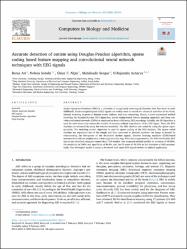| dc.contributor.author | Arı, Berna | |
| dc.contributor.author | Sobahi, Nebras | |
| dc.contributor.author | Alçin, Ömer Faruk | |
| dc.contributor.author | Sengur, Abdulkadir | |
| dc.contributor.author | Acharya, U.Rajendra | |
| dc.date.accessioned | 2022-03-22T13:14:44Z | |
| dc.date.available | 2022-03-22T13:14:44Z | |
| dc.date.issued | 2022 | en_US |
| dc.identifier.citation | Ari, B., Sobahi, N., Alçin, Ö. F., Sengur, A., & Acharya, U. R. (2022). Accurate detection of autism using Douglas-Peucker algorithm, sparse coding based feature mapping and convolutional neural network techniques with EEG signals. Computers in Biology and Medicine, 143, 105311. | en_US |
| dc.identifier.uri | https://doi.org/10.1016/j.compbiomed.2022.105311 | |
| dc.identifier.uri | https://hdl.handle.net/20.500.12899/781 | |
| dc.description.abstract | Autism Spectrum Disorders (ASD) is a collection of complicated neurological disorders that first show in early childhood. Electroencephalogram (EEG) signals are widely used to record the electrical activities of the brain. Manual screening is prone to human errors, tedious, and time-consuming. Hence, a novel automated method involving the Douglas-Peucker (DP) algorithm, sparse coding-based feature mapping approach, and deep convolutional neural networks (CNNs) is employed to detect ASD using EEG recordings. Initially, the DP algorithm is used for each channel to reduce the number of samples without degradation of the EEG signal. Then, the EEG rhythms are extracted by using the wavelet transform. The EEG rhythms are coded by using the sparse representation. The matching pursuit algorithm is used for sparse coding of the EEG rhythms. The sparse coded rhythms are segmented into 8 bits length and then converted to decimal numbers. An image is formed by concatenating the histograms of the decimated rhythm signals. Extreme learning machines (ELM)-based autoencoders (AE) are employed at a data augmentation step. After data augmentation, the ASD and healthy EEG signals are classified using pre-trained deep CNN models. Our proposed method yielded an accuracy of 98.88%, the sensitivity of 100% and specificity of 96.4%, and the F1-score of 99.19% in the detection of ASD automatically. Our developed model is ready to be tested with more EEG signals before its clinical application. | en_US |
| dc.language.iso | en | en_US |
| dc.publisher | Elsevier B.V. All | en_US |
| dc.relation.ispartof | Computers in Biology and Medicine | en_US |
| dc.rights | info:eu-repo/semantics/closedAccess | en_US |
| dc.subject | Autism spectrum disorder | en_US |
| dc.subject | EEG signals | en_US |
| dc.subject | Douglas-Peucker algorithm | en_US |
| dc.subject | Deep learning | en_US |
| dc.title | Accurate detection of autism using Douglas-Peucker algorithm, sparse coding based feature mapping and convolutional neural network techniques with EEG signals | en_US |
| dc.type | Article | en_US |
| dc.authorid | https://orcid.org/ 0000-0002-2917-3736 | en_US |
| dc.department | MTÖ Üniversitesi, Mühendislik ve Doğa Bilimleri Fakültesi, Elektrik-Elektronik Mühendisliği Bölümü | en_US |
| dc.institutionauthor | Alçin, Ömer Faruk | |
| dc.identifier.doi | 10.1016/j.compbiomed.2022.105311 | |
| dc.identifier.volume | 143 | en_US |
| dc.identifier.issue | 105311 | en_US |
| dc.identifier.startpage | 1 | en_US |
| dc.identifier.endpage | 10 | en_US |
| dc.relation.publicationcategory | Makale - Uluslararası Hakemli Dergi - Kurum Öğretim Elemanı | en_US |
| dc.identifier.pmid | 35158117 | |
| dc.identifier.scopus | 2-s2.0-85124383156 | en_US |
| dc.identifier.wos | WOS:000790189400006 | en_US |
| dc.identifier.wosquality | Q1 | en_US |
| dc.indekslendigikaynak | Web of Science | en_US |
| dc.indekslendigikaynak | PubMed | en_US |


















